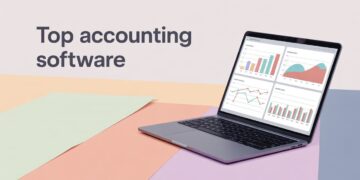Your website will be most successful if you know where it’s at, and where it’s heading. Analytics tools help you understand who your audience is, how they think, how effective your website is, and how it may be adjusted. Here’s how tracking analytics can drive your business’s growth.
Numbers into actions
Website analytics are the digital footprints your visitors (and potential customers) leave behind. Their clicks, scrolls, and interaction with your site tell you about what’s working and what isn’t. When you build a website today, most platforms offer built-in data and analytics especially when using business website templates designed to support performance tracking. Companies leveraging analytics see higher revenue growth. The power lies in transforming the raw numbers into actionable insights.
Beyond traffic metrics
Most website owners are familiar with pageviews and visitor counts. These are just basic metrics. More comprehensive analytics include user flow patterns across pages, conversion funnels and abandonment points, content engagement, attribution models for marketing channels, and behavioral cohorts.
In other words, you’ll see where visitors click, and at which point they decide to buy something or leave. You’ll know which blog posts keep people reading and which ones they abandon after one paragraph. You’ll understand which marketing channels (Facebook ads, email newsletters, etc.) are actually bringing customers to your site. And you’ll be able to group your visitors into categories based on their behavior (one-time bargain hunters versus repeat customers, for example).
Understanding these deeper metrics can inform your business strategy. Knowing your homepage gets 10,000 monthly visitors doesn’t mean too much without also knowing that 80% leave within 15 seconds, for example. That knowledge can inform your decisions and help optimize your site.
Decision making
A significant advantage of analytics is eliminating the guesswork from your business decisions. Each design change, content strategy, and marketing investment is backed up by data. If you consider the approach of “I think we should redesign this product page because it looks outdated” versus “The analytics show this page has an 80% bounce rate compared to our blog’s 50%. Heat mapping shows they rarely scroll past the first image”, you can quickly see how advanced metrics provide clarity about a potential problem.
Unexpected insights driving growth
Some valuable discoveries come from unexpected patterns. Time-based analytics show you when people visit your site through the day and week. Companies can often spot distinct audience segments they weren’t targeting intentionally. They might find their traffic is unusually high at 3 a.m., or significant engagement during lunch hours. These aren’t random fluctuations but specific groups of users with distinct needs and circumstances. The late-night visitors might be international customers, shift workers, or parents with newborns. Lunchtime traffic might indicate professionals looking for solutions during their breaks. Once you’ve identified patterns, you can better target content, offers, or features specifically for these overlooked audiences, potentially unlocking new revenue streams.
Similarly, page engagement analytics can contradict assumptions about what actually drives conversions. For example, time spent on pricing pages versus feature pages might reveal that customers prioritize value over detailed technical specifications. Such information can inform your marketing strategies and improve conversion rates.
When businesses let analytics guide their understanding of customer priorities (rather than relying on assumptions), they often discover opportunities to match actual customer preferences.
The cost of flying blind
Not tracking analytics means missed opportunities, but also actively wasted resources. Without proper tracking, marketing budgets may be allocated to channels driving the wrong sort of traffic, or development time focused on features users don’t find valuable, or content creation with minimal impact. A small or medium e-commerce business may spend several months developing a feature they later find out that only 2% of customers clicked on. If they’d implemented event tracking earlier, they could have run a quick A/B test and saved those resources for more impactful projects.
In this way, analytics serve as a kind of reality check to prevent costly diversions.
Easy implementation
When you create your site on one of the best website builders, analytics integration requires little more than clicking a switch. More sophisticated tools can be implemented with some technical knowledge through tag managers or direct integration options. For many business owners, the analytics included with a website builder will be sufficient and can help drive growth. The initial setup is quick and easy, and the insights could save many hours of misguided effort down the line.
What’s beneficial for small businesses is that platforms now offer pre-configured analytics dashboards designed for non-technical users. These intuitive interfaces show you key metrics in plain language, often with recommendations about what the numbers might mean for your company. You don’t need a data science degree to understand the insights, and you don’t need experience in web design to alter what might not be working.
The technical barrier has never been lower, which means the primary challenge isn’t collecting data but how to apply it. The question is how effectively you’ll use the insights to drive significant business growth.
Data collection and growth strategy
So how to transform the numbers into strategy? Here’s a basic pattern to follow.
- Identify key performance indicators
- Establish measurement frameworks for the KPIs
- Schedule regular reporting cadences
- Analyze trends and any anomalies
- Form hypotheses about user behavior
- Test hypotheses with controlled experiments
- Implement winning variations
- Repeat the cycle with further insights.
A systematic approach such as the one above can turn passive observation into an active growth engine. Each cycle of the process can bring new improvements for exponential growth.
The key is in creating tight feedback loops between data collection and action. Some organizations fall into the trap of collecting data for months before making any decisions. In contrast, teams that implement “minimum viable measurements” (that provide enough insight to inform the next action) can make consistent progress.
Privacy concerns
Modern analytics bring important privacy considerations. Regulations like GDPR and CCPA mean your business must manage users’ data properly. Transparent data policies, clear opt-in mechanisms, and data minimization principles should be prioritized. Privacy-first analytics can actually produce more useful data by focusing on meaningful, consented interactions rather than capturing everything possible.
Analysis paralysis?
Analysis paralysis can sometimes occur when businesses collect large amounts of data without a clear plan for turning those insights into action. A marketing team might diligently set up tracking for dozens of metrics (bounce rates, click-through rates, exit pages, etc.) and generate comprehensive reports with charts and detailed breakdowns. But instead of clarity, team meetings devolve into debates about which metrics actually deserve attention.
This kind of paralysis normally stems from one or more of the following: lack of prioritization, absence of decision frameworks (teams need systematic methods for evaluating data), and the perfect-information fallacy (a belief that with more data, the perfect decision will become obvious).
The solution isn’t reducing data collection but being clear on what metrics matter for your specific objectives. Develop an approach where primary metrics inform your strategy; secondary metrics provide context; and tertiary metrics are available for more investigation if needed.
Last word
Analytics amplify the effectiveness of each of your other initiatives from marketing to product development to UX design. With website builders now offering built-in analytics, it has never been easier to build a professional site and access data to drive your business’s growth.








